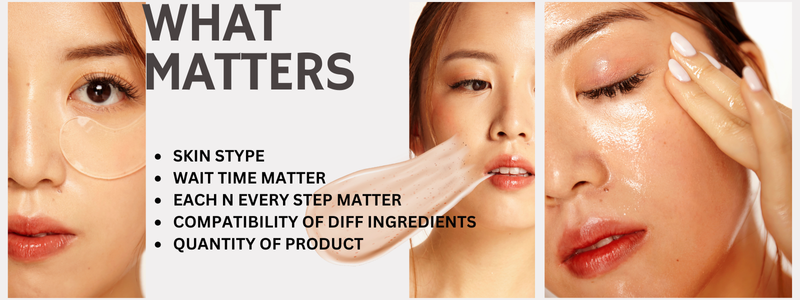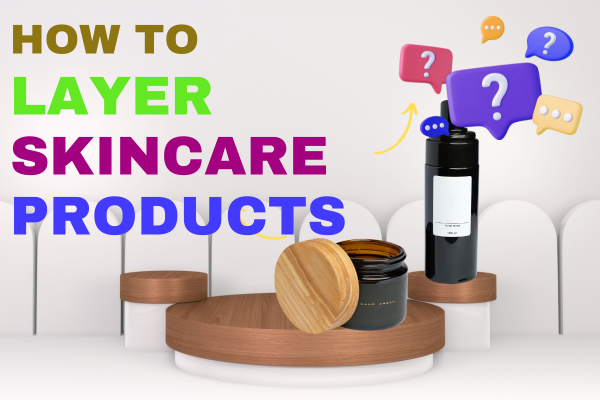Regarding skincare, it’s not just about what you use—it’s about how you use it. Most people do not know how to layer skincare products actually. Layering your skincare products in the correct order is essential for maximizing their benefits. If you mix up the order or skip steps, you could be reducing their effectiveness. Layering properly lets your skin absorb the right ingredients at the right time, helping you get that healthy glow. But how do you do it correctly? Let’s break it down step by step.
Lets See How to Layer Skincare Products
Table of Contents
Why Order Matters
Applying your skincare products in the correct sequence can penetrate the skin properly and deliver the ingredients where they are most needed.
The general rule of thumb is to apply products from thinnest to thickest consistency. This ensures that lightweight serums, which are packed with active ingredients, can reach deep into the skin before you lock in moisture with heavier creams.
The Difference Between Morning and Evening Routines–
Your skincare needs are different during the day and at night. In the morning, your skin needs protection from environmental aggressors like pollution and UV rays, while at night, it’s all about repair and replenishment.
This is why the order of products, and sometimes the products themselves, will differ.
Key Steps in How to Layer Skincare Products

Step 1: Cleanse
Cleansing is the first and most important step in any skincare routine. It helps remove makeup, dirt, and impurities that have accumulated on your skin throughout the day or night.
Types of cleansers:
- Oil-based cleansers: Great for removing makeup and sunscreen without stripping your skin.
- Water-based cleansers: Ideal for removing sweat and dirt, leaving your skin fresh.
Cleansing is essential because it prepares your skin to absorb the following products. If your skin isn’t properly cleansed, other products won’t penetrate as effectively.
Step 2: Tone
A toner helps to rebalance your skin’s pH level and remove any residual impurities left after cleansing. Think of it as the first layer of hydration.
Different types of toners:
- Hydrating toners: Perfect for dry or sensitive skin.
- Exfoliating toners: Help with acne-prone or oily skin by gently removing dead skin cells.
Step 3: Apply Serums
Serums are potent treatments packed with active ingredients, targeting specific skin concerns like hydration, brightening, or anti-aging.
How to choose the right serum: Look for serums with ingredients that address your skin’s needs, like vitamin C for brightening or hyaluronic acid for hydration.
Step 4: Moisturize
Moisturizers help lock in hydration and create a protective barrier on your skin. Even oily skin needs moisture; skipping this step can lead to your skin producing more oil to compensate.
Best practices for choosing a moisturizer: Choose based on your skin type. For example, if you have dry skin, opt for a thicker cream. If you have oily skin, a lightweight gel might be more suitable.
Step 5: Sunscreen (Daytime Only)
Never skip sunscreen during the day! It’s the most crucial step in protecting your skin from harmful UV rays that cause aging, hyperpigmentation, and even skin cancer.
Physical vs. chemical sunscreens: Physical sunscreens contain zinc oxide or titanium dioxide and work by sitting on top of your skin to block UV rays, while chemical sunscreens absorb UV rays.
Evening Skincare Routine
Your evening skincare routine should focus on repair and hydration since your skin regenerates at night.
Step 6: Night time Treatments
At night, it’s time for heavier treatments, like retinol, which speeds up cell turnover, or other actives like AHAs or BHAs that help exfoliate the skin. These products are designed to work while your body is in repair mode.
Retinol: Known for its anti-aging benefits, retinol should be applied at night and layered under a moisturizer.
How to Choose the Right Products for Your Skin Type
Knowing your skin type is key to selecting the right products.
- Dry skin: Look for hydrating and nourishing ingredients like hyaluronic acid and ceramides.
- Oily skin: Choose lightweight products and ingredients like salicylic acid.
- Combination skin: Use balancing products that aren’t too rich but provide adequate moisture.
- Sensitive skin: Opt for fragrance-free and soothing ingredients like aloe Vera or niacinamide.
Common Skincare Layering Mistakes to Avoid

- Skipping steps: Every step has a purpose, so don’t skip steps like toning or moisturizing.
- Mixing incompatible ingredients: Some ingredients, like retinol and vitamin C, don’t mix well and can irritate your skin.
- Using too many products: More isn’t always better. Too many active ingredients can overwhelm your skin.
Pro Tips for How to Layer Skincare Products
- Wait time between layers: Allow each product to absorb before applying the next. This helps prevent pilling.
- Watch for reactions: If your skin feels irritated, scale back the number of products you’re using.
Customizing Your Routine for Maximum Benefits
As your skin’s needs change with the seasons, so should your routine. For example, you might need a heavier moisturizer in winter and a lighter one in summer. Also, consider adding masks or exfoliation once or twice a week to enhance your routine.
Conclusion
How to Layer Skincare Products correctly is the secret to a glowing, healthy complexion. Follow the steps outlined above, and you’ll maximize the benefits of your skincare products.
Remember, consistency is key, and understanding your skin’s unique needs will help you choose the right products for the best results.
FAQs
1. How long should I wait between applying products?
Ideally, wait 30 seconds to a minute between each layer to allow the products to absorb properly.
2. Can I mix different serums in one routine?
Yes, but be cautious. Some ingredients don’t mix well, like retinol and vitamin C. Always check for compatibility.
3. What’s the best way to layer serums?
Apply serums from thinnest to thickest consistency, starting with water-based serums and finishing with oil-based ones.
4. Should I use the same routine every day?
Your routine can be customized based on your skin’s daily.

